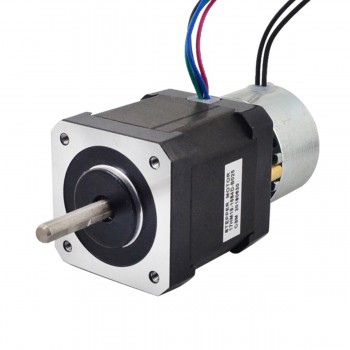1.Brief description of waterproof stepper motors
Waterproof stepper motors are stepper motors that can work normally under a certain waterproof level. It effectively prevents water, dust, etc. from entering the motor through special shell design and waterproof shaft seal and other technical means, so as to maintain normal operation in harsh environments. Waterproof stepper motors have the advantages of high efficiency, stability and reliability, and are widely used in home appliances, machinery, automobiles and other industries.
2.Design features of waterproof stepper motors
1.Insulation material: The motor winding adopts polyethylene insulation and nylon household waterproof electromagnetic wire. The cable connection method is based on cable joint technology. The seam insulation is removed from the scraped paint layer, the welding is firm, and the raw rubber is wrapped around the layer to ensure waterproofing.
2.Anti-corrosion material: The outer part of the motor is made of anti-corrosion material or anti-corrosion coating, and the sealing mechanism blocks the cracks or channels that may exist inside and outside to ensure that water does not enter the motor and cause short circuit failure.
3.IP protection level: The motor industry has a standardized liquid protection measure called IP protection level, which power engineering and motor manufacturers need to meet the application specification requirements.
3.Structural composition of waterproof stepper motors
1.Housing: Made of stainless steel, it has good waterproof and dustproof performance and can work normally in harsh environments.
2.Motor drive part: It includes the motor body, circuit board and power supply, providing efficient and stable power output.
3.Bearing: High-strength bearings are used to withstand high loads and high speed requirements.
4.Sealing ring: Made of high-strength materials, it effectively prevents corrosion and moisture from penetrating into the motor.
5.Stator: The stator is the stationary part of the stepper motor, usually composed of multiple poles, which can be permanent magnets or electromagnets. Its main function is to generate a magnetic field and drive the rotor to rotate.
6.Rotor: The rotor is the rotating part of the stepper motor, usually made of magnetic materials, which can be permanent magnets or soft magnetic materials. Its main function is to generate torque under the action of the magnetic field generated by the stator to rotate the motor.
7.Winding: The winding is the conductive part of the stepper motor, usually wound around the magnetic poles of the stator, generating an electromagnetic field to drive the rotor to rotate.
8.Controller: The controller is the control part of the stepper motor, responsible for receiving pulse signals and converting them into motor rotation, usually including drive circuits, pulse distributors and microprocessors, etc.
9.Encoder: The encoder is the feedback part of the stepper motor, used to detect the rotation position and speed of the motor, usually including photoelectric encoders, magnetic encoders or Hall sensors.
4.Precautions for the use of waterproof stepper motors
1.Control signal line and power supply connection: Make sure that the control signal line is firmly connected, and it is best to consider shielding issues at industrial sites. The power supply voltage should be appropriate, and the +/- polarity of the DC input must not be connected incorrectly. The motor model or current setting value on the drive controller should be appropriate.
2.Grounding method: Be sure to understand the grounding method. Using floating without connection may cause the motor to work unstably. Closely observe the status of the motor within half an hour of starting operation, such as whether the movement is normal, the sound and temperature rise, and stop and adjust immediately if any problems are found.
3.Use environment: Although waterproof stepper motors can be used in dusty, humid or oily places, it does not mean that they can work in water. Try to place them in a relatively clean environment and avoid long-term immersion in water.
4.Maintenance and care: Regularly check the exterior, fixed parts, output shaft, encoder connection cable, power connector, cooling fan, etc. of the stepper motor to ensure that they are firmly connected and operate normally. Clean dust and oil in time to ensure that the motor is in normal condition.
5.Cable protection: Ensure that the cable is not subjected to torque or vertical load due to external bending force or its own weight, especially at the cable outlet or connection. In the case of moving stepper motors, the cable should be firmly fixed to a stationary part, and it should be extended with an additional cable installed in the cable support to reduce bending stress.
6.Load control: Ensure that the radial and axial loads applied to the stepper motor shaft during installation and operation are controlled within the specified values for each model. It is best to use a flexible coupling to reduce load damage or wear on the shaft end and bearings.
7.Installation precautions: When installing/removing the coupling component to the stepper motor shaft end, do not hit the shaft end directly with a hammer to avoid damaging the encoder. Try to align the shaft end to the best state to avoid vibration or bearing damage.
Source:https://plaza.rakuten.co.jp/yixing/diary/202412260000/





























